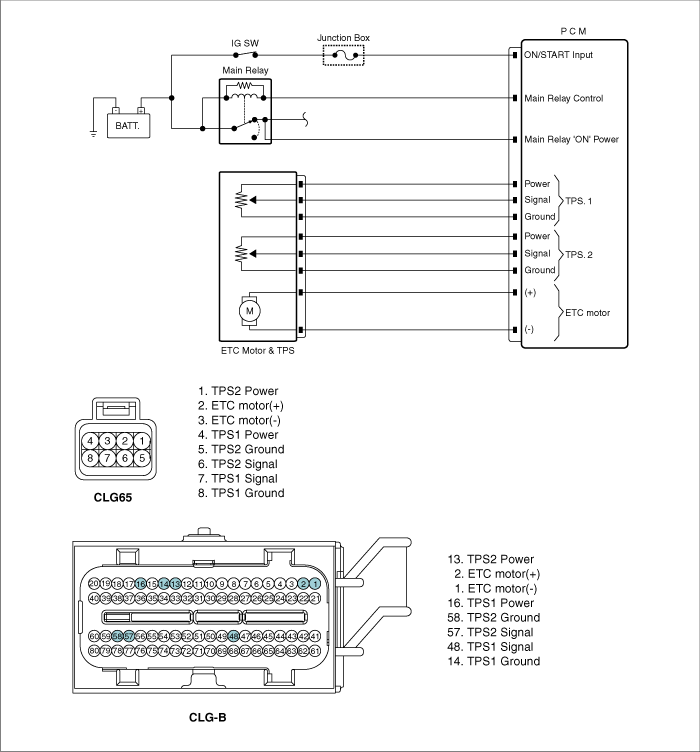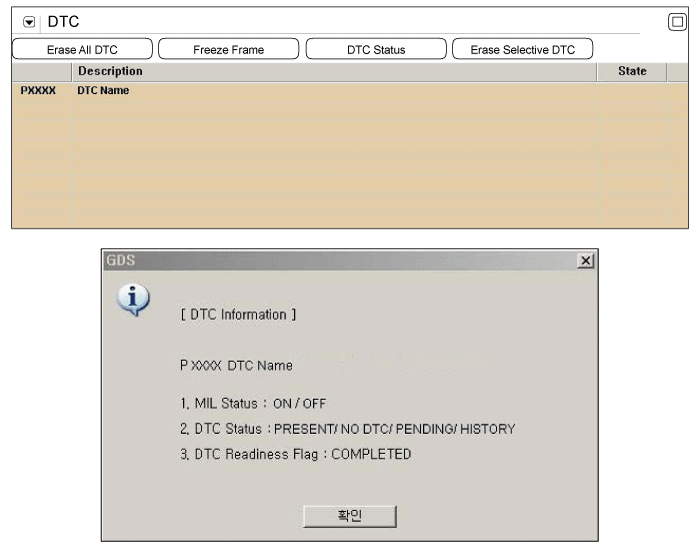
The Electronic Throttle
Control(ETC) system is made of the components throttle body, Throttle
Position Sensor(TPS)1&2 and Accelerator Position Sensor(APS) 1&2.
The throttle body contains the actuator, the throttle plate and the
throttle position sensor (potentiometer), which are integrated in one
housing. The actuator consists of a DC motor with a two-stage gear. The
opening angle of the throttle valve is detected by the throttle position
sensor which is mounted on the throttle body. And it provides feedback to
the PCM to control the throttle motor in order to control the throttle
valve opening angle properly in response to the driving
condition.
Checking output signals
from TPS under detecting condition, if the difference between real and
target throttle position is above the specified value, PCM sets P0638 and
then MIL(Malfunction Indication Lamp) turns on.
Item
|
Detecting
Condition
|
Possible cause
|
DTC Strategy
|
| •
|
Monitor the throttle
position | |
|
Enable Conditions
|
|
Thresh
old
value
|
Case1
|
| •
|
The difference between the real ETS
motor & TPS value and the target ETS motor & TPS value
is over 4.5°. | |
Case2
|
| •
|
When real Throttle position is below
36°, (the real throttle position - the target throttle
position) < - 4.5° | |
Case3
|
| •
|
(the real throttle position - the target
throttle position) < -
18° | |
Diagnosis Time
|
|
MIL On Condition
|
|
※ If Main relay has a
fault(ex. Open) while the engine is running, the
DTCs,P0638/P0685/P1295/P2106, can happen at the same time.
<DTC
Name>
| - |
P0638 Throttle Actuator Control
Range/Performance(Bank 1) |
| - |
P0685 PCM/PCM Power Relay Control Circuit
/Open |
| - |
P1295 Throttle Actuator Control System - Power
Management |
| - |
P2106 Throttle Actuator Control System -
Forced Limited Power |
Throttle opening ( °
)
|
Output voltage (V) [Vref =
5.0V]
|
TPS1
|
TPS2
|
0°
|
0.0V
|
5.0V
|
10°
|
0.5V
|
4.5V
|
20°
|
0.9V
|
4.1V
|
30°
|
1.4V
|
3.6V
|
40°
|
1.8V
|
3.2V
|
50°
|
2.3V
|
2.7V
|
60°
|
2.7V
|
2.3V
|
70°
|
3.2V
|
1.8V
|
80°
|
3.6V
|
1.4V
|
90°
|
4.1V
|
0.9V
|
100°
|
4.5V
|
0.5V
|
110°
|
5.0V
|
0.0V
|


| 1. |
Check DTC Status
| (1) |
Connect scantool to Data Link
Connector(DLC). |
| (3) |
Select "DTC" button, and then Press "DTC
Status" to check DTC's information from the DTCs
menu. |
| (4) |
Read "DTC Status"
parameter.

|
| (5) |
Is parameter displayed "Present
fault"?
|

|
▶ Go
to "Terminal and connector inspection"
procedure.
|
|

|
▶
Fault is intermittent caused by poor contact in the
sensor's and/or PCM's connector or was repaired and PCM
memory was not cleared. Thoroughly check connectors for
looseness, poor connection, ending, corrosion,
contamination, deterioration, or damage. Repair or
replace as necessary and go to "Verification of Vehicle
Repair"
procedure.
|
| |
| Terminal And Connector
Inspection |
| 1. |
Many malfunctions in the electrical system are
caused by poor harness and terminal condition. Faults can also be
caused by interference from other electrical systems, and mechanical
or chemical damage. |
| 2. |
Thoroughly check connectors for looseness,
poor connection, bending, corrosion, contamination, deterioration,
or damage. |
| 3. |
Has a problem been found?
|

|
▶ Repair as
necessary and go to "Verification of Vehicle Repair"
procedure
|
|

|
▶ Go to "
Control Circuit Inspection "
procedure.
|
|
| Control Circuit
Inspection |
■ Check voltage
| 2. |
Disconnect ETC Motor & TPS
connector. |
| 4. |
Measure the voltage between ETC motor(+)/(-)
of ETC Motor & TPS harness connector and chassis
ground.
Specification
: Approx. B+
| |
| 5. |
Is the measured voltage within
specification?
|

|
▶ Go to
"Component Inspection" procedure.
|
|

|
▶ Go to
"Check open in harness" as
follows.
|
|
■ Check open in harness
| 2. |
Disconnect ETC Motor & TPS connector and
PCM connector. |
| 3. |
Measure the resistance between ETC motor (+)
terminal of ETC Motor & TPS harness connector and ETC motor (+)
terminal of PCM harness connector. |
| 4. |
Measure the resistance between ETC motor (-)
terminal of ETC Motor & TPS harness connector and ETC motor (-)
terminal of PCM harness connector.
Specification
: Approx. below 1Ω
| |
| 5. |
Is the measured resistance within
specification ?
|

|
▶ Go to
"Component Inspection" procedure.
|
|

|
▶ Repair
open in motor harness and go to "Verification of Vehicle
Repair"
procedure.
|
|
■ Check throttle valve for stuck
| 2. |
Disconnect the air hose between throttle body
and air mass flow sensor. |
| 3. |
Check stuck on throttle
valve. |
| 4. |
Is the throttle valve normal?
|

|
▶ Go to
"Check ETC motor resistance" as follows.
|
|

|
▶ Repair or
replace as necessary and go to "Verification of Vehicle
Repair"
procedure.
|
|
■ Check ETC motor resistance
| 2. |
Disconnect ETC Motor & TPS
connector. |
| 3. |
Measure the resistance between ETC motor(+)
and (-) terminals of ETC Motor & TPS connector (component
side).
Specification
: Approx. 1.275 ~ 1.725Ω @
23°C(73.4°F)
| |
| 4. |
Is the measured resistance within
specification?
|

|
▶ Go to
"ETC motor actuation test" procedure.
|
|

|
▶
Substitute with a known - good ETC motor and check for proper
operation. If the problem is corrected, replace ETC motor and
go to "Verification of Vehicle Repair"
procedure.
|
※ Procedure of ETS Initialization
1. Erase the trouble codes on PCM
2. Turn the ignition key off and keep this
condition until the main relay is turned off.(It will takes 10
second)
3. Turn ignition key on more than 1second to
record the throttle motor position on the
EEPROM |
■ ETC motor actuation test
| 2. |
Connect ETC motor & TPS
connector. |
| 3. |
After IG "ON", execute the "ETC motor
actuation test" by Scantool.

|
| 4. |
Does the "ETC motor actuation test" execute
normally ?
|

|
▶
Substitute with a known - good PCM and check for proper
operation. If the problem is corrected, replace PCM and go to
"Verification of Vehicle Repair" procedure.
|
|

|
▶
Substitute with a known - good ETC motor and check for proper
operation. If the problem is corrected, replace ETC motor and
go to "Verification of Vehicle Repair"
procedure.
|
※ Procedure of ETS Initialization
1. Erase the trouble codes on PCM
2. Turn the ignition key off and keep this
condition until the main relay is turned off.(It will take 10
seconds)
3. Turn ignition key on more than 1second to
record the throttle motor position on the
EEPROM |
| Verification Of Vehicle
Repair |
After a repair, it is
essential to verify that the fault has been corrected.
| 1. |
Connect scantool and select "DTC"
button. |
| 2. |
Press "DTC Status" button and confirm that
"DTC Readiness Flag" indicates "Completed". If not, drive the
vehicle within conditions noted in the freeze frame data or enable
conditions |
| 3. |
Read "DTC Status"
parameter |
| 4. |
Is parameter displayed "History(Not Present)
fault"?
|

|
▶ System
performing to specification at this time. Clear the
DTC
|
|

|
▶ Go to the
applicable troubleshooting
procedure.
|
|